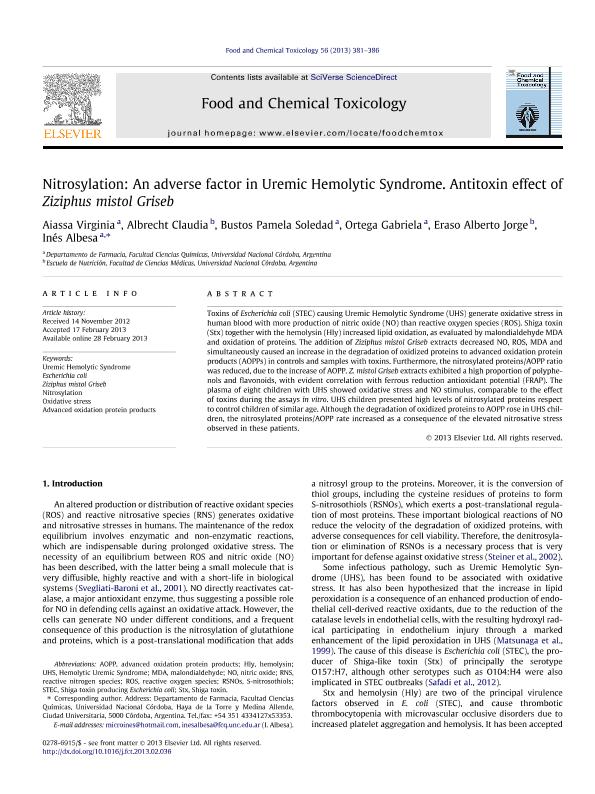Artículo
Nitosylation: an adverse factor in Hemolytic Uremic Syndrome. Antitoxin effect of Ziziphus mistol Griseb
Aiassa, Virginia ; Albrecht, Claudia
; Albrecht, Claudia ; Bustos, Pamela Soledad
; Bustos, Pamela Soledad ; Ortega, Gabriela Alicia; Eraso, Alberto Jorge; Albesa, Inés
; Ortega, Gabriela Alicia; Eraso, Alberto Jorge; Albesa, Inés
 ; Albrecht, Claudia
; Albrecht, Claudia ; Bustos, Pamela Soledad
; Bustos, Pamela Soledad ; Ortega, Gabriela Alicia; Eraso, Alberto Jorge; Albesa, Inés
; Ortega, Gabriela Alicia; Eraso, Alberto Jorge; Albesa, Inés
Fecha de publicación:
02/2013
Editorial:
Elsevier
Revista:
Food And Chemical Toxicology
ISSN:
0278-6915
Idioma:
Inglés
Tipo de recurso:
Artículo publicado
Clasificación temática:
Resumen
Toxins of Escherichia coli (STEC) causing Uremic Hemolytic Syndrome (UHS) generate oxidative stress in human blood with more production of nitric oxide (NO) than reactive oxygen species (ROS). Shiga toxin (Stx) together with the hemolysin (Hly) increased lipid oxidation, as evaluated by malondialdehyde MDA and oxidation of proteins. The addition of Ziziphus mistol Griseb extracts decreased NO, ROS, MDA and simultaneously caused an increase in the degradation of oxidized proteins to advanced oxidation protein products (AOPPs) in controls and samples with toxins. Furthermore, the nitrosylated proteins/AOPP ratio was reduced, due to the increase of AOPP. Z. mistol Griseb extracts exhibited a high proportion of polyphenols and flavonoids, with evident correlation with ferrous reduction antioxidant potential (FRAP). The plasma of eight children with UHS showed oxidative stress and NO stimulus, comparable to the effect of toxins during the assays in vitro. UHS children presented high levels of nitrosylated proteins respect to control children of similar age. Although the degradation of oxidized proteins to AOPP rose in UHS children, the nitrosylated proteins/AOPP rate increased as a consequence of the elevated nitrosative stress observed in these patients.
Archivos asociados
Licencia
Identificadores
Colecciones
Articulos(CCT - CORDOBA)
Articulos de CTRO.CIENTIFICO TECNOL.CONICET - CORDOBA
Articulos de CTRO.CIENTIFICO TECNOL.CONICET - CORDOBA
Citación
Aiassa, Virginia; Albrecht, Claudia; Bustos, Pamela Soledad; Ortega, Gabriela Alicia; Eraso, Alberto Jorge; et al.; Nitosylation: an adverse factor in Hemolytic Uremic Syndrome. Antitoxin effect of Ziziphus mistol Griseb; Elsevier; Food And Chemical Toxicology; 56; 2-2013; 381-386
Compartir
Altmétricas



